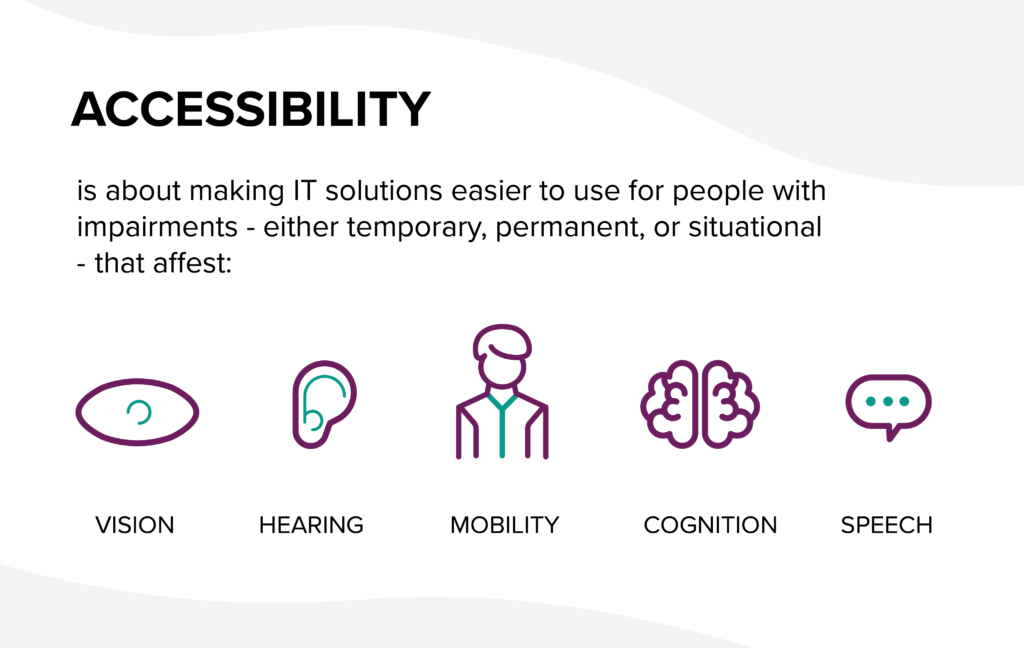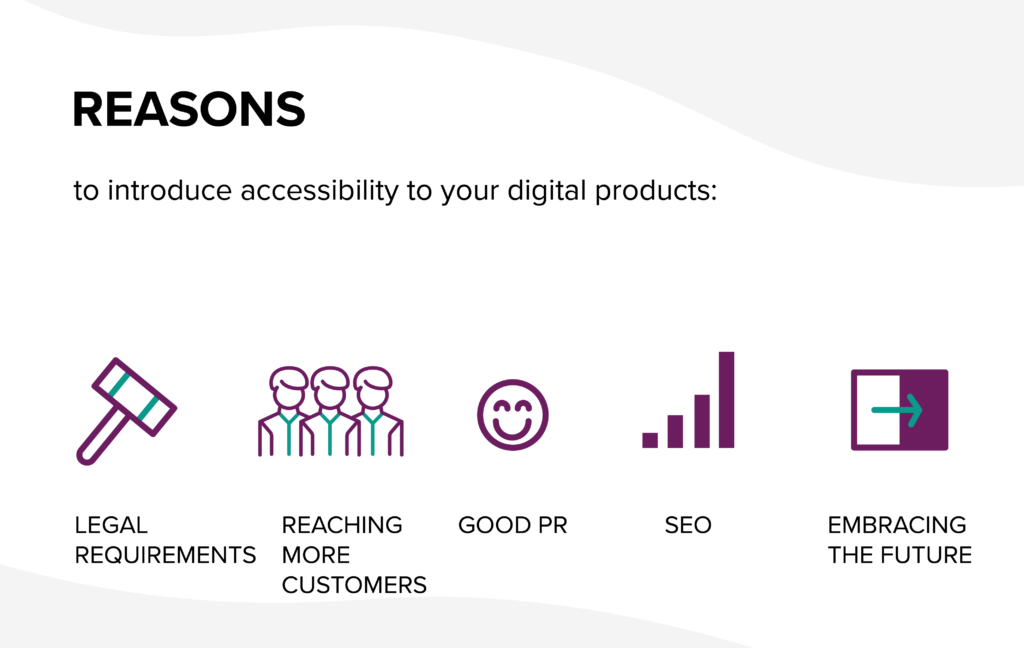If you have your own websites or digital products, accessibility should be an important pillar of their design. In this article, I’m going to tell you why.
In 2021, design experts widely recognize accessibility as a key part of product design. Unfortunately, it’s far from becoming a market standard.
For instance, around 98% of websites on the Internet are still not accessible. And we’re not talking about some archaic remnants from 10 years ago, but about carefully designed, great looking portals. Many of them excel at usability, have top-notch responsiveness, and are overall modern – but simply lack accessibility.
And today, accessibility is not a nice-to-have anymore. Did you know that in many regions around the world digital accessibility is required by law? For example, the UE became such a place not long ago.
But don’t worry – I’m not here to scare you. Before you start googling if you should save some money for potential fines, I’ll tell you more about accessibility itself and its strong benefits for your organization. And if by the end of this article you decide to join the family of accessible digital solutions (either because of the benefits or because you’ll learn that… you have to), I’m also going to tell you how to do it.
What is Accessibility?
First, let’s define what accessibility is, exactly.
Generally, accessibility refers to a product or service being approachable to someone with disabilities. Citing Adobe, accessibility involves two key elements – how users with disabilities access electronic information and how web pages are designed to work with assistive devices used by people with disabilities.
Yet, the range of disabilities is difficult to categorize. From a broad perspective, disabilities include visual, hearing, cognitive, and motor impairments. Additionally, each of these categories also includes a wider range of conditions. For instance, visual impairments include blindness, color blindness, or limited vision.
Apart from that, accessibility also relates to temporary disabilities. Someone working in IT with a broken arm or wrist may find it problematic to write on a keyboard, and yet still needs to use a computer. This also falls under the category of accessible solutions.


Why is Accessibility Important
I already mentioned you may need to implement accessibility due to legal regulations. But even if your region is free of such laws, you still may want to make your solutions accessible – simply, because it’s worth it.
Now, let’s look at the specifics.


Reason 1: Adhering to Legal Regulations
In the US, suing for a lack of accessibility is becoming more and more common. Essential Accessibility reports that web accessibility litigation continues to steadily grow in 2021 – both in federal and state courts. But the issue isn’t new; already a few years back, in 2016, Bag’n Baggage had to pay $4,000 in damages to a plaintiff who couldn’t shop independently on the company’s website. And while some may call these lawsuits frivolous, as for now, the court rulings have overwhelmingly favored plaintiffs.
The ground for these rulings is mainly the Americans with Disabilities Act of 1990 (ADA). But there are also other relevant regulations, like the City Human Rights Law in New York or the Unruh Act in California.
The European Union is joining this landscape. Soon, not only the public sector but also private entrepreneurs will have to adhere to accessibility regulations. The basis for this is directive 2016/2102 and directive 2019/882 – also called the European accessibility act.
On the website of the European Commission, you can learn that the European accessibility act covers products and services identified as the most important for people with disabilities (and also most likely neglected across EU countries).
This includes:
- computers and operating systems;
- ATMs, ticketing, and check-in machines;
- Smartphones;
- TV equipment related to digital television services;
- telephony services and related equipment;
- access to audio-visual media services such as television broadcast and related consumer equipment;
- services related to air, bus, rail, and waterborne passenger transport;
- banking services;
- e-books;
- e-commerce.
So, if you’re operating in the EU in any of these industries, you will have to implement accessibility within your products.
Reason 2: Reaching Millions of Customers
However, as I said, you shouldn’t think of accessibility as merely a legal necessity. By making your products accessible, you can, for instance, reach a broader group of users.
Now, executives in many companies view accessibility as a feature for disabled people. And that’s wrong – because, often, their idea of a disabled person is flawed.[1]
And here’s why: every year, the number of disabled individuals is growing. According to WHO, as of today, the percentage of disabled people all over the world reached a staggering 20%. In Europe only, there are 135 million people with some sort of impairments. At the same time, more and more impaired individuals enjoy successful professional careers.
And making their work more accessible is only one thing. Since people with disabilities earn money like any other person, they’d also like to spend it somewhere. And since e-commerce grew insanely in recent years, it should offer an accessible experience to not exclude a wide range of potential customers.
There’s more. Imagine these exemplary scenarios:
- you broke your right hand, and luck has it, you’re right-handed. To move more comfortably, you decide to buy bigger clothes online. You’re not very skilled at using a mouse with your left hand, that’s why you decide to navigate on a fashion retailer’s website with the arrows on your keyboard. Yet, it doesn’t work. This option was never implemented. What a shame. You switch to a website that offers this option.
- You just had eye surgery (no more glasses!). After some time, to make sure your eyes are healing just fine, you need to return to the clinic for a control visit. You browse their website to book an appointment… and can’t read a thing. You still haven’t fully recovered, and the font is too small and sophisticated. Zooming in is also not a viable solution – everything gets fuzzy. Well, it’s a shame the clinic didn’t foresee this issue.
- You’re getting older. And older! In 3 months, you’re going to celebrate your 80th birthday. You’d like to buy some nice party accessories (after all, you’re young at heart!). The landing page of your favorite online store recently implemented a slider with promos… and it’s moving way too swiftly. You’re not able to read its content. Maybe if you were 50 years younger, it wouldn’t be an issue, but you don’t read that quickly anymore. Unfortunately, the slider can’t be stopped. So, there’s only one thing left for you to do – leave the website disappointed. And visit one that lets you read what it has to offer.
Ergo, as you can see, accessibility isn’t only about disablements per se. It’s about making life easier for all kinds of people.
[1] And also, because accessibility isn’t a feature. It’s a human right – ignoring it is a form of discrimination.
Reason 3: It’s Great PR
Despite all the things I’ve mentioned in this text, accessibility still isn’t a market standard – far from it (remember the WebAim statistic?).
Many websites love to brag about their responsive web design (RWD) or overall usability. However, these elements hardly impress anyone anymore.
But if you instead point out you’ve invested time and research into well-working accessibility functionalities, that’s a different story. Making digital solutions accessible still is a relatively new topic (unfortunately). Although relevant regulations are in place for some time now, the problem itself isn’t widely known or understood. And that’s why it’s your chance to excel at something unique, and, at the same time, socially important.
Reason 4: SEO
Nearly every article about the topic emphasizes how much accessibility boosts your SEO. Unfortunately, in 2021, this thesis is debatable.
Indeed, some metrics have a clear impact on SEO. These metrics are, for example, linking in a way that is described in accessibility norms, or creating accessible titles, headlines, and alt texts. But that’s pretty much it.
However, SEO is dynamic and competitive. And since accessibility is so widely linked (pun not intended) with SEO, in my opinion, it’s only a matter of time before more clear accessibility metrics will play a key role in search optimization. So, to stay ahead of your competition, you should view SEO aspects as a reason to make your products and services accessible now. Later on, it might be way more difficult to gain an organic boost.
Reason 5: Embracing the Future
If you’re from the age of around 55 to, let’s say, 8 (in that case, congratulations on reading this!), computer-rich environments are your natural habitat. However, in the US only around 28% of people aged 80+ have an internet connection at home. Maybe that’s one of the reasons why seniors tend to be overlooked in design efforts.
Yet, digitalization will only continue, and people who started using computers, smartphones, and tablets when they were young will be getting increasingly older. As a result, the issues described in “Reason 2” will become more and more popular.
And it’s not difficult to calculate that this situation is only a few years away.
Think About Accessibility First
I recommend thinking about accessibility before you start designing your product. Making a website or product accessible after it’s been developed is way more problematic (and expensive) than implementing dedicated elements from the start.
If I convinced you to introduce accessibility into your solutions but you don’t know where to start, click the banner below. PGS Software can help you in all of your design activities.






